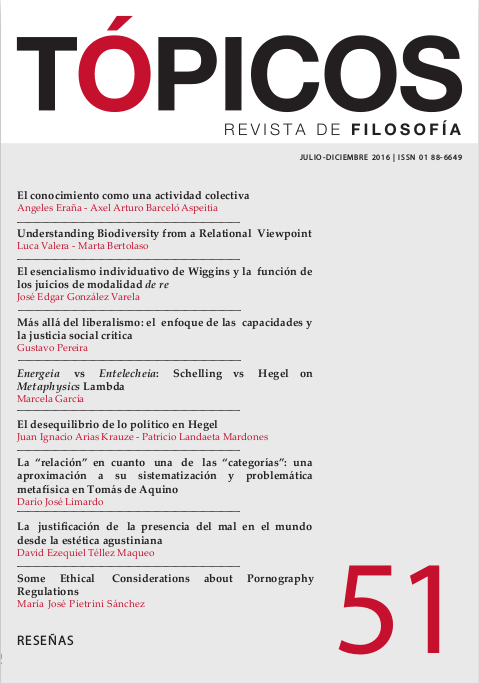Publicado 2016-07-01
Palabras clave
- pornografía,
- feministas radicales,
- feministas liberales,
- violencia de género,
- libertad de expresión
Cómo citar
Resumen
El objetivo de este artículo es proponer cuatro condiciones éticas para la regulación de la pornografía en un Estado con tendencia liberal democrática: las dos primeras se relacionan con la producción del material pornográfico, la tercera con el contenido de dicho material y la cuarta con su repercusión social. De acuerdo con ello, en primer lugar, se presenta una definición de pornografía que incluye las perspectivas de las feministas radicales y liberales. En segundo lugar, se desarrolla un marco normativo para determinar cuándo un material pornográfico es éticamente permisible y cuándo no. Finalmente, se sugiere una recomendación en relación a lo que el Estado debería hacer en cada caso y se hace una distinción entre tres ámbitos: (i) las condiciones bajo las cuales es producido el material pornográfico, (ii) el contenido de lo que representa o describe, y (iii) sus consecuencias sociales. Se concluye que el Estado no debería censurar todos los materiales pornográficos, como las feministas radicales insisten, sino sólo prohibir y castigar aquellos que no cumplan con las condiciones éticas que se proponen.
Referencias
- About Project Unbreakable - Project Unbreakable. (2013). Retrieved March 22, 2016, from http://project-unbreakable.org/about/
- Almodovar, N. J. (2006). Porn Stars, Radical Feminists, Cops, and Outlaw Whores: The Battle Between Feminist Theory and Reality, Free Speech, and Free Spirits. In Prostitution and Pornography, Philosophical Debate about the Sex Industry. J. Spector (Ed.) (149-174). Stanford, CA: Stanford University Press.
- Bourdieu P. & Wacquant L. J. D. (1996). An Invitation to reflexive sociology. Chicago: The University of Chicago Press.
- Convention on the Elimination of all form of Discrimination Against Women. (CEDAW). (1992). General recommendations made by the Committee on the Elimination of Discrimination against Women. Retrieved May 27, 2016, from http://www.un.org/womenwatch/daw/cedaw/recommendations/recomm.htm#recom19 General Recommendation No. 19 (llth session, 1992)
- Dworkin, A. (1981). Pornography: Men possessing women. New York: Perigee Books.
- Dworkin, R. (1993). Women and Pornography. New York Review of Books, XL (17).
- Dyzenhaus, D. (1992). John Stuart Mill and the Harm of Pornography. Ethics, 102(3), 534-551.
- Easton, S. M. (1994). The problem of pornography: Regulation and the right to free speech. London: Routledge.
- Eaton, A. (2007). A Sensible Anti-Porn Feminism. Ethics, 117(4), 674-715. Feinberg, J. (1985). O ense to Others: The Moral Limits of the Criminal Law. New York: Oxford University Press.
- Fish, S. E. (1994). There is no Such Thing as Free Speech... And it’s a good thing too. New York: Oxford University Press.
- Goodman, N. (1976). Languages of Art: An approach to a Theory of Symbols. 2nd edition, Indianapolis: Hackett Publishing Company.
- Langton, R. (1993). Speech Acts and Unspeakable Acts. Philosophy and Public Affairs, 22(4), 293-330.
- ____ (1990). Whose Right? Ronald Dworkin, Women, and Pornographers. Philosophy and Public A airs, 19(4), 311-359.
- Longino, H. E. (1980). Pornography, Oppression and Freedom: A Closer Look. Take Back the Night: Women on Pornography. L. Lederer (Ed.) (40-54). New York: Morrow.
- McElroy, W. (1995). XXX: A Woman’s Right to Pornography. New York: St. Martin’s Press.
- Mackinnon, C. (1993). Only Words. Cambridge, MA: Harvard University Press.
- ____ (1989). Towards a Feminist Theory of State. Cambridge, MA: Harvard University Press
- ____ (1987). Feminist Unmodi ed. Cambridge, MA: Harvard University Press.
- ____ (1985). Pornography, Civil Rights and Speech. In Pornography: Women, Violence and Civil Liberties. C. I in (Ed.) (456-551). New York: Oxford University Press.
- Mill, J. S. (1975). On the liberty. Three Essays. New York: Oxford University Press.
- Nussbaum, M. (1999). Rage and Reason. Sex and Social Justice (239-252). New York: Oxford University Press.
- Preciado, B. (2008). Testo Yonque. Espasa: Madrid.
- Schwarzenbach, S. (2006). Contractarians and Feminists Debate Prostitution. In Prostitution and Pornography, Philosophical Debate about the Sex Industry. J. Spector (Ed.) (209-239). Stanford, CA: Stanford University Press.
- Scoccia, D. (1996). Can Liberals Support a Ban on Violent Pornography?Ethics, 106(4), 776–799.
- Strossen, N. (1995). Defending Pornography: Free Speech, Sex and the Fight for Women’s Rights. New York: Scribner. United Nations. The Universal Declaration of Human Rights (UDHR). Retrieved May 27, 2016, from http://www.un.org/en/universal- declaration-human-rights/index.html
- United Nations. The Universal Declaration of Human Rights (UDHR). Retrieved May 27, 2016, from http://www.un.org/en/universal-declaration-human-rights/index.html
- United Nations General Assembly (UNGA). (1993). Declaration on the Elimination of Violence against Women. Res 48/104, 48. (No.49) at 217, U.N.Doc.A7-48/49. Retrieved May 27, 2016, from http://www1.umn.edu/humanrts/instree/e4devw.htm
- West, C. (2006). The Free Speech Argument against Pornography. Canadian Journal of Philosophy, 33(3), 391-422.







